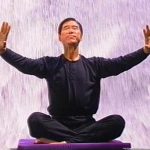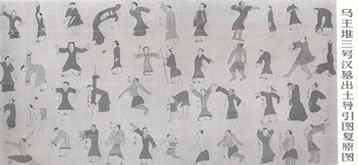Qigong (气功) Posted by Stephen on Jan 10, 2012 in Culture
 I’ve been told that it is best to make decisions over the space of seven breaths. It helps, mostly because it allows you to slow down and fully weigh your options. However, it wasn’t until I started practicing tai chi (太极拳) and kung fu (功夫) that I learned the true value of controlled breathing and its benefits on mental and physical health.
I’ve been told that it is best to make decisions over the space of seven breaths. It helps, mostly because it allows you to slow down and fully weigh your options. However, it wasn’t until I started practicing tai chi (太极拳) and kung fu (功夫) that I learned the true value of controlled breathing and its benefits on mental and physical health.
Qigong or 气功 (qì gōng) is the philosophy and practice of aligning breath, physical activity and awareness for mental, spiritual and corporeal health, as well as the development of human potential. It includes certain forms of martial arts and inward focus on meditation. Qigong, as a form of traditional Chinese medicine, is a type of “breathing calisthenics” designed to bring balance to one’s internal organs, while simultaneously limiting stress and improving mind-body harmony.
Theory (理论)
The central idea in qigong practice is the control and manipulation of qi (气), a form of internalized energy or spirit. This energy is considered to exist in all things including the air, water, food, and sunlight. In the body, qi represents the unseen vital force that sustains life. Qigong practice involves the manipulation and balance of the qi within the practitioner’s body and its interaction with the practitioner’s surroundings.
According to Qigong theory, people are born with original amounts of qi. A person gains qi from consumption of food by eating, from the air by breathing and from interacting with their environment. Supposedly, a person becomes ill or dies when the amount or type of qi is unbalanced within the body. The practice of qigong is to regulate and control the qi within the body. Thus, Qigong practices work to either build up and replenish your body’s qi (usually through breathing) and release it (usually through physical exercise).
Forms and Practice
Dynamic qigong involves a series of carefully choreographed movements or gestures that are designed to promote and manipulate the flow of qi within the practitioner’s body. T’ai Chi Chuan, a Chinese martial art, is one well-known representation of dynamic qigong (see National Geographic video below of Shaolin monks). Other examples include Five animal frolics or White Crane Qigong, Wild Goose (Dayan) Qigong in which the practitioner performs movements to mimic motions of animals. To an external observer, the series of movements are similar to calisthenics or other types of athletic endeavor.
http://www.youtube.com/watch?v=tX8mGt0K_JI
Static qigong is performed by holding a certain posture, position or stance for a period of time and bears many similarities to the practice of Yoga. Yiquan, a Chinese martial art derived from xingyiquan, is a strong proponent of stance training. Eight pieces of brocade (Baduanjin qigong), a well known set of health exercises, is also based on a series of postures. To the external observer, the practitioner appears to be fixed in space. To the qigong practitioner, the physical and mental effort required to keep the posture results in the appropriate manipulation of qi.
Meditative qigong is a popular method of mind body training and can be found in a vast array of Eastern cultures. In Confucius scholar tradition, the meditation is focused on humanity and virtue with the aim of self-enlightenment. In one of the Buddhist methods, the aim is to “still the mind”, either through a focus outward such as a place, inwards such as the breath, a mantra, a koan, emptiness or the idea of the eternal as represented by a Buddha. In Daoist and Chinese traditions, meditative qigong seeks to lead qi through the proper meridian pathways with the aim of bringing balance and harmony to the patient.
Try it yourself:

Build vocabulary, practice pronunciation, and more with Transparent Language Online. Available anytime, anywhere, on any device.
About the Author: Stephen
Writer and blogger for all things China related. Follow me on twitter: @seeitbelieveit -- My Background: Fluent Mandarin speaker with 3+ years working, living, studying and teaching throughout the mainland. Student of Kung Fu and avid photographer and documentarian.





Leave a comment: